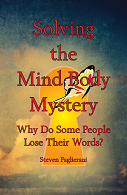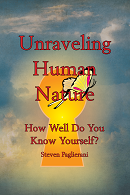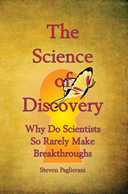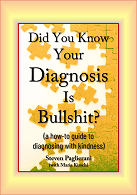
The Science of Discovery
(why do scientists so rarely make breakthroughs?)
978-0-9844895-2-7 $24.95
Why Are Breakthroughs So Rare?
Everything scientists do is intended to lead to discoveries. No coincidence, we reward scientists who make meaningful discoveries with things like the Nobel Prize. Clearly, discoveries are the universal holy grail of science. Yet strangely, close to 100% of scientific efforts fail to discover anything. Why? And why does no one ever mention this?
This is not to say scientists discover nothing, let alone nothing meaningful. Every life on this planet is better because of science's advancements. Moreover, scientists themselves are some of the brightest, most amazing people. So how do we explain their close to perfect record of failures?
In part, this book will explore this mystery—why the current scientific method so rarely succeeds. This book will claim the problem lies not with scientists but rather, with their method. But what if scientists had a method which enabled them to make discoveries every time out?
In the opening chapters, this book will describe what such a method would need to be like. We'll then test this method on everything from sleep problems and weight loss issues to the nature of deafness, cancer, meditation, and learning the times tables.
Can we possibly discover anything new? Prepare to be amazed.
SCI043000 SCIENCE / Research and Methodology
SCI075000 SCIENCE / Philosophy & Social Aspects
Creating The Four Sciences (one of constellated science's maps)
In this video, Steven demonstrates one of constellated science's, "natural maps." This particular map describes the internal structure of the new scientific method. Pay particular attention to how the entire map emerges from just two questions. Answering these two questions then leads to the unbroken sequence of logic from which the entire map emerges. Thus nothing in this map can ever be ad hoc. This alone addresses many of the current scientific method's shortcomings.
Transcript of the Video
In this video, we're going to look at one of constellated science's maps. The title of this map is, "The Creation of the Four Sciences." Like all maps in constellated sciences, this one begins with two tipping point based questions. And answering those two questions then creates the entire map in an unbroken sequence of logic.
So how does this work?
Asking the Two Questions
This map uses the two questions—the vertical axis question, "is this thing visible?"; the "thing" being the thing we're exploring scientifically—and the horizontal axis question, "does this thing change?"
So on the vertical axis, we'll be placing the two answers—this thing is visible and this thing is not visible. And on the horizontal axis, we'll be placing the two answers—this thing does change and this thing does not change. Notice, there is no in between. And those answers can only be exactly as they've been stated. So those are the two questions.
The next thing that we do is to begin to create the map itself. And to do this, we draw the horizontal and vertical axes simply across. And at the endpoints of each of the arms of the cross, there's an arrow pointing the direction in which this answer tips.
So drawing those two arrows; having drawn the two arrows, we now place the answers into the map. And so for the vertical axis question—is this thing visible?—the invisible answer goes at the top of this axis, and the visible answer goes on the bottom.
On the horizontal axis, the does this thing change question—the changing, "it does change" answer goes on the left end of the horizontal axis. And the unchange, the "it is not changing answer" goes on the right.
So there are, for instance, if you combine invisible and change—these two answers, which go in the upper left quadrant—these are patterns of invisible change. No need to change any of the words. The words are already there.
If we look at the upper right quadrant, you see patterns of invisible unchange. And clearly, this phrase comes from combining the two answers that the arrow touches. On the bottom half of the drawing on the left-hand side, we have patterns of visible change. And on the bottom right-hand side, we have patterns of visible unchange.
Now if you think about it logically, there are no other possibilities for anything that science could explore. Either we are going to see patterns of invisible change or invisible unchange, or patterns of visible change or visible unchange. Logically, there can be no other possibilities.
Now this is really important because the idea that there are the four answers and the idea that there are the four scientific patterns—this number four comes up again and again in constellated science. And in some sense, what it does is it functions similarly to how the corner pieces in a puzzle function. The four most important pieces in any puzzle are the four corner pieces. Once you have them, you have defined the theoretical limits of the puzzle. And you would then probably look for the sides that have a straight edge, and you would begin to build the outline.
The Four Kinds of Evidence
In these maps, we work from the inside out. But we work to construct those four corner pieces in. As I said, we do this in an unbroken sequence of logic. So those four scientific patterns also have another function. The same way we just joined adjacent answers now creates the four kinds of evidence. So if you look at the upper left quadrant, patterns of invisible change, you find the kind of evidence called intuitions. And quite honestly, conventional science tends to leave this out, even though there are some occasional references to intuition from geniuses like Einstein. As far as being a part of a scientific method though, this is almost never mentioned. In fact, it's excluded most of the time. Very strange.
Patterns of invisible unchange—this type of evidence is called concepts. OK.
In the lower left-hand quadrant, the patterns of visible change are called experiments. And if you think about it, that's pretty easy to see. You have a sequence of things that you are doing to try to get to an outcome. And so you are watching for the changes that occur during this sequence. And it's an experiment if it's clearly defined.
And in the lower right-hand corner, the patterns of visible unchange are facts. And this can take a little bit of thinking about. But the word fact here means patterns of visible unchange.
For instance, the outcome of a horse race—the outcome is a fact. And that fact is only true in that particular race at that moment in time and space. Were the same horses to run the race again a half an hour later, we don't know that the outcome would be the same. It might, but it might not. And so a fact is something that doesn't change. And you can see it—visible unchange. OK, so those are the four kinds of evidence.
The Four Kinds of Discoveries
In the next use of this, we label the quadrants. And so these quadrants now become the four types of discoveries that you can make—the four kinds of things that you can discover using constellated science.
So in the upper left-hand corner, we make intuitive discoveries. In the upper right-hand corner, we make rational discoveries. In the lower left-hand corner, we make empirical discoveries. And in the lower right-hand corner, we make material discoveries. So here you see the four types of discoveries. Again, notice that nothing is ad hoc. These things are still emerging from the two questions we began with.
Now the next thing is to add in the four boundary brackets. And these boundary brackets function like the pieces in a puzzle with straight edges. There are the four corner pieces. And there are the pieces with straight edges that span between each corner. And together, they create the outside boundaries of a puzzle.
Everything that science is exploring begins as a puzzle. We want to know what it really looks like—not just logical. We want to see it just as we see a puzzle finished. We want to know what the picture is in all its parts so we can look it over. And this is true of science as well.
We want to know what this looks like completely. And we want to be reassured that it's complete. And so those boundary brackets are about to be the outside edges which define this science.
The Four Kinds of Science
So what comes next is we join adjacent kinds of discoveries. And since discovery is the main function and focus of science, if you join adjacent discoveries, you get the four kinds of science that we can do.
So we can do physical science, which is very common. And physical science is the combination of the lower quadrants. So empirical discoveries plus material discoveries—this is physical science.
Mental science—things that we would do about the mind, for instance—are the combination of intuitive discoveries and rational discoveries. If we do the left pair of quadrants, adjacent quadrants, we have real world science, which is the combination of intuitive discoveries and empirical discoveries. And if we go to the right side of the map, the two quadrants that get joined are the rational discoveries and the material discoveries. And those create theoretical science.
The ideas behind this map at this point are extremely complex. But for one thing, being able to separate the mind and the body or energy and matter is one or two of the things which the vertical axis accomplishes. And the horizontal axis—the idea of real world science and theoretical science—is extremely important in that so often science, conventional science, poses theoretical ideas, which then when they are put into the real world, don't quite meet the standards for what a true science would be.
They're limited in application, et cetera. There are changes that can't be accounted for. And part of that is because there is no division in science between real world science and theoretical science.
They are, according to this map though, they're different. Real world science essentially is about things that change both visible and invisible, intuitive and empirical. And theoretical science is limited to things that do not change—rational concepts and material measurements. So in this way, this map accounts for both and renders to each realm what each realm does best.
The Emergence of Constellated Science
So now, if we then move to what emerges from the entire map—the map of the sciences, those four sciences—if you combine all of them, an emergent quality appears, which is in and of itself constellated science. Constellated science is what emerges when you simultaneously include all four types of science. And of course, this takes a bit of work.
But if you are watching how the map is unfolding, everything in constellated science uses the same kind of a map—the same sequence from two questions to four answers, and then combining adjacent answers into the four quadrants or kinds of change or types of evidence, and then combining the adjacent quadrants into the four realms or states of this entire science.
So in this map, we have mental science, physical science, theoretical science, and real world science combined in a way that cohesiveness emerges. A whole, a property, that's not immediately evident when just looking at the parts. The entirety then becomes science itself.
So in this way, what we've just seen is an example of the way that one of constellated science's maps emerge. And, as I said, there are many things that are here to think about. And when we come back, we'll talk about how this map addresses many of the shortcomings of the current method. And before that, I will show you the way that the map emerges—the logic itself, the bare-bones skeleton underneath all of the words that we've just seen.
Books by Steven Paglierani



.png)

.png)